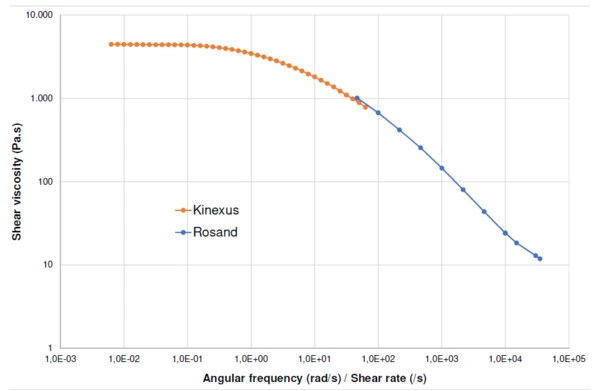Introduction
The shear rate of interest for rheological measurements is dependent on the application. In a fast process like spraying, where the material is rapidly pushed through an orifice, high shear rates up to 100,000 s-1 are involved. On the contrary, the extrusion of a polymer, which has much higher viscosity, is done at significantly lower speeds; typically more than 1000-time lower. Even lower shear rates are used to describe very slow processes as levelling.
Rheometer Versions
The choice of the rheometer depends on the required shear rate. While Kinexus, as a rotational rheometer, is the instrument of choice to measure in the low shear rate range, one will work with a Rosand capillary rheometer to reach high shear rates up to 1,000,000 s-1.
In the following, the viscosity curve of a polypropylene material is obtained over almost 7 decades. For that, both a NETZSCH Kinexus rotational rheometer and NETZSCH Rosand capillary rheometer are used (see measurements conditions in table 1).
Table 1: Measurement conditions
| Instrument | Kinexus |
|---|---|
| Sample | Polypropylene |
| Geometry | Plate-plate, diameter: 25 mm |
| Temperature | 190°C |
| Measurement gap | 1 mm |
| Frequency | 10-3 to 10 Hz |
| Shear StressStress is defined as a level of force applied on a sample with a well-defined cross section. (Stress = force/area). Samples having a circular or rectangular cross section can be compressed or stretched. Elastic materials like rubber can be stretched up to 5 to 10 times their original length.stress | 1,000 Pa |
| Instrument | Rosand |
|---|---|
| Temperature | 190°C |
| Capillary die | Diameter: 1 mm and 0.5 mm, Length: 16 mm |
| Zero die | Diameter: 1 mm and 0.5 mm, Length: 0.25 mm |
| Pressure transducer capillary side | 10,000 Psi (689.5 bar) |
| Pressure transducer zero side | 1,500 Psi (103.4 bar) |
Remarks about the Measurement Conditions
- Kinexus Rotational Rheometer
A frequency sweep was performed, and not, as one might think, a rotation measurement. Here, the Cox-Merz rule was used that stipulates that for unfilled polymers, complex shear viscosity vs frequency gives the same values as shear viscosity vs shear rate. Oscillation measurements have the advantage over rotation measurements that the material is measured at rest. Thus, the polymer is not subjected to centrifugal forces and will not run out of the gap as it might happen during rotational measurements at high shear rates. You will find more information about this topic in Application Notes 236 and 243 [1, 2]. - Rosand Capillary Rheometer
The 1 mm-diameter die was used to get shear rates up to 10,000 s-1, while higher shear rates were reached with the 0.5 mm-diameter die.
Measurement Results
Figure 1 depicts the composite viscosity curve of poly-propylene measured in the rotational and capillary rheometers. In the low shear rate range, the material shows a Newtonian behavior: The shear viscosity does not depend on the shear rate. In this zero-shear plateau, the shear viscosity amounts to 4400 Pa·s.
For higher shear rates, the polymer is Shear ThinningThe most common type of non-Newtonian behavior is shear thinning or pseudoplastic flow, where the fluid viscosity decreases with increasing shear.shear-thinning: Its shear viscosity decreases with increasing shear rates. In this range, the applied shear StressStress is defined as a level of force applied on a sample with a well-defined cross section. (Stress = force/area). Samples having a circular or rectangular cross section can be compressed or stretched. Elastic materials like rubber can be stretched up to 5 to 10 times their original length.stress is high enough to disentangle the polymer chains. They can slide against each other, facilitating the flowing, and explaining the shear viscosity decrease.

Conclusion
With this unique combination of rotational and capillary rheometer measurements offered by NETZSCH, very broad shear rate ranges are achieved. This is important, for example, for polymers, because their behavior depends strongly of the shear rate to which they are subjected.